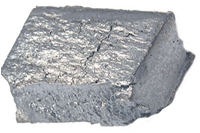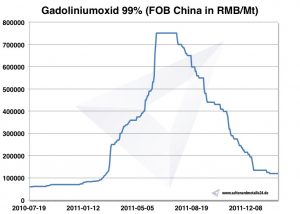Gadolinium, Gd, atomic number 64
Aeneral
Gadolinium is a chemical element with the element symbol Gd and the atomic number 64. In the periodic table it is in the group of lanthanides and thus also belongs to the metals of the rare earths.
The first element of the Ytterer earth in the periodic table was found 1880 spectroscopically by Jean Charles Galissard de Marignac in didym and gadolinite. 1886 he made it as a white oxide from Samarskit and called it Y from Samarskit. In the same year Paul Emile Lecoq de Boisbaudran also produced gadolinium oxide and named the new element after the discoverer of the mineral gadolinite, the Finnish chemist Johan Gadolin, gadolinium.
Only 1935 succeeded Georges Urbain the representation of the metal.
Of course, gadolinium occurs only in compounds. Technically important are Monazit and Bastnäsit. Gadolinite deposits in the Ytterby Mine, north of Stockholm, are now exhausted.
Recovery
After a complex separation of the other Gadoliniumbegleiter the oxide is reacted with hydrogen fluoride to Gadoliniuimfluorid. Subsequently, this is reduced with calcium with the formation of calcium fluoride to the metallic gadolinium. The separation of remaining calcium residues and impurities takes place in an additional remelting in vacuo.
Features
The silvery white to greyish white shiny rare earth metal is ductile and malleable. At temperatures above 1508 K, the densest sphere packing transforms into a cubic-body-centered crystal structure. In dry air gadolinium is relatively stable, in moist air it forms a non-protective, loosely adherent and peeling oxide layer. It reacts slowly with water. In dilute acids it dissolves.
Gadolinium has with 49.000 barn the highest thermal neutron capture cross section of all known stable elements due to its contained isotope Gd-157 (with 254.000 barn) (only the unstable Xe-135 surpasses Gd-157 by a factor 10). The high burn-off rate severely restricts use as a control rod in nuclear reactors.
Together with dysprosium, holmium, erbium and terbium, which are also assigned to the group of lanthanides, it is one of the only elements - except iron, cobalt and nickel - that have a ferromagnetism. However, it must first be brought below its ferromagnetic Curie temperature of 292,5 K (19,3 ° C). [6]
Contrary to many references, gadolinium is not superconductive. This is also based on the experience that contamination of ferromagnetic substances such as iron and gadolinium destroys the superconductivity of other elements. However, high-temperature ceramic superconductors of the type Ba2GdCu3O7-x with a transition temperature between 80-85 K are known.
Dusts of metallic gadolinium are hazardous to fire and explosive.
Usage
Gadolinium is used to make gadolinium yttrium garnet for microwave applications. Oxysulfides are used to produce green phosphor for luminescent screens (radar).
Intravenously injected gadolinium (III) compounds, such as gadopentetate dimeglumine, serve as contrast agents in MRI examinations. For this purpose complexing agents with high complexing constants, such as, for example, the chelates DTPA (diethylenetriaminepentaacetic acid) and DOTA (1,4,7,10-tetraazacyclododecane-1,4,7,10-tetraacetic acid, with Gd = gadoteric acid) are used because of the high toxicity of free gadolinium ions. Due to the seven unpaired electrons in the f shell, gadolinium is highly paramagnetic. The contrast agent thus allows the surrounding protons - essentially water - to relax more quickly. This significantly increases the contrast differences between different tissues in an MRI scan.
These contrast agents can also be used for studies on the brain, since the gadolinium complexes do not overcome the blood-brain barrier in healthy patients and thus a blood-brain barrier disorder - an indication of a pathological event (eg deficient circulation, tumor, inflammation) - make visible.
Gadolinium gallium garnet was used to make magnetic bubble stores. It is also used in the production of rewritable compact discs.
Additions of 1% gadolinium increase the machinability and the high temperature and oxidation resistance of iron and chromium alloys. Corresponding gadolinium iron cobalt alloys can be used for optomagnetic data storage.
Gadolinium, because it has a Curie point near room temperature, could be used in coolers that operate on the principle of adiabatic magnetization. Such refrigerators would do without the ozone layer damaging chlorofluorocarbons (CFCs) and would have no subject to mechanical damage parts.
Gadolinium is used in the form of gadolinium oxide in modern fuel assemblies as a burnable absorber material which, after a fuel change at the beginning of the operating cycle, limits the excess reactivity of the reactor due to an excess of nuclear fuel. As the fuel burns, the gadolinium is also degraded. [7]
Terbium-doped gadolinium oxysulfide (Gd2O2S: Tb) is a scintillator commonly used in X-ray technology. Gd2O2S: Tb emits light with a wavelength of 545nm.
There is no known biological function of gadolinium.
Free gadolinium ions behave in a similar way to calcium ions, ie they are mainly incorporated in the liver and bone system and can remain there for years. Free gadolinium also acts as a calcium antagonist - the ionic radii of calcium and gadolinium are nearly equal - affecting the myocardial contractility and inhibiting the clotting system. [9]
Intravenously applied solutions of free gadolinium ions are acutely toxic. The toxicity affects smooth and striated muscles, mitochondrial function and blood coagulation. [10]
The toxicity of free gadolinium is considered to be high. In complexed form, such as the gadolinium in the approved contrast media, it is generally well tolerated considering the contraindications. Since 2006, there are increasing reports that kidney-deficient patients may experience nephrogenic systemic fibrosis after administration of various chelates of gadolinium, particularly Gd-DTPA.
| General | |
| Name, symbol
ordinal |
Gadolinium, Gd, 64 |
| Series | lanthanides |
| Group, period, block | La, 6, f |
| Appearance | silvery white |
| CAS number | 7440-54-2 |
| Mass fraction of the earth's envelope | 5,9 ppm |
| Atomic | |
| atomic mass | 157,25 u |
| atomic radius | 188 pm |
| Covalent radius | 196 pm |
| Elektronenkonf. | [Xe] 4f (7) 5d (1) 6s2 |
| 1. ionization | 593,4 KJ / mol |
| 2. ionization | 1170 KJ / mol |
| 3. ionization | 1990 KJ / mol |
| Physically | |
| Physical state | fixed |
| crystal structure | hexagonal |
| density | 7,886 g / cm3 (25 ° C) |
| magnetism | paramagnetic (χm = 0,12) |
| melting point | 1585 K (1312 C) |
| boiling point | 3523 K (3250 C) |
| Molar volume | 19,90 * 10 (-6) m (3) / mol |
| Heat of vaporization | 305 KJ / mol |
| heat of fusion | 10,0 KJ / mol |
| Electric conductivity | 0,763 * 10 (6) A / (V * m) |
| thermal conductivity | 11 W / (m * K) |



